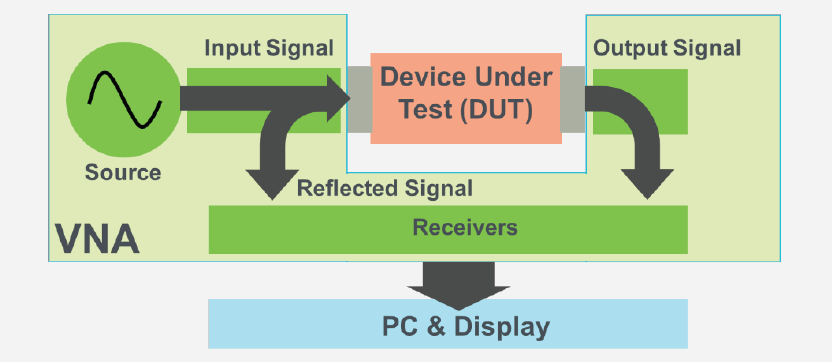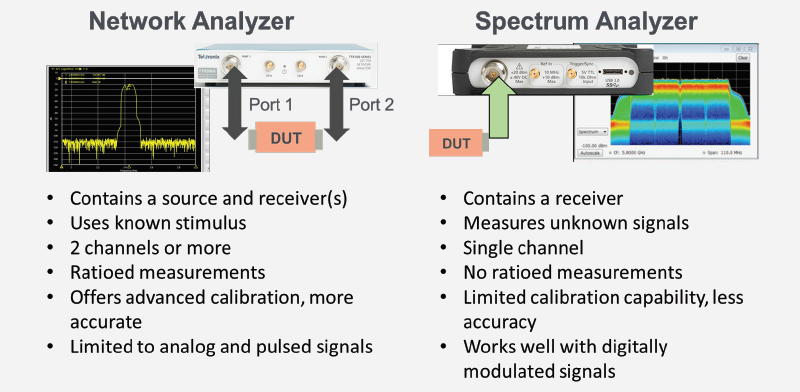

Did you know vector network analyzers, or VNAs, were invented in the early1950s long before any of our current networks were in place? At that time, they were used to measure network parameters of electrical networks. Now they are also used to test component specifications and verify design simulations to make sure systems and their components are working hand-in-hand.
Now that Tektronix has introduced the TTR500 Series, high-performing VNAs are far more affordable than they have been for a very long time. VNAs are back and back in a big way. Since VNAs have been so expensive and hard to use, many potential users found other solutions or simply went without. In this post, we thought it would make sense to re-acquaint everyone with VNA basics such as:
· Who needs one
· How VNAs operate
· Key VNA specifications
· VNAs vs. spectrum analyzers
In follow on posts, we’ll cover calibration techniques, types of measurement errors, S-Parameters, and typical VNA measurements.
Who needs one
A wide variety of engineering disciplines use VNAs. Engineers involved in product development use VNAs at numerous stages in the design process. Component designers use VNAs to verify performance. System designers use VNAs to verify that system performance meets their subsystem and system specs. Another use is in manufacturing to ensure products are in spec before they’re shipped. Yet another application is for field operations who use VNAs to verify and troubleshoot deployed RF and microwave systems.
How VNAs operate
VNAs contain a source and a set of receivers. These let you generate a known stimulus signal and determine changes to the stimulus caused by the device under test (DUT). The simple figure below shows how a VNA operates with the source coming from one port. The stimulus signal is injected into the DUT and VNA measures the signal on the input side as well as the signal that passes through to the output side of the DUT. The receivers then compare the results to the known stimulus signal. The combined results are processed inside the instrument by an internal or external PC and sent to a display for analysis by the user.

VNAs contain both a stimulus source and receivers to provide a very accurate closed loop for evaluating DUTs.
Key VNA specifications
The perfect instrument is one that serves your needs well, is affordable, user-friendly, reliable, and will address your needs now as well as in the future. While these may sound fundamental, remember that not all VNAs are created equal. Make sure you trust the manufacturer, that you’ll the get the support you need, and that it isn’t so complex you won’t want to use it.
Here’s a rundown on some of the most important specifications to consider when selecting a VNA.
Frequency range – DUTs have an operational frequency, but some of you may need to measure harmonic frequencies too. Active components, such as amplifiers and converters may need to be tested at their harmonic frequencies which are 2 to 5 times greater than operational frequency. You may want a higher frequency range but since it can become a major cost driver, consider your application when weighing this specification.
Dynamic range – This is the measurable attenuation range for a specified frequency range. Make sure the DUT noise floor is at least 10 dB above the VNA spec. For example, if the VNA is specified with 120 dB dynamic range, the noise floor of your DUT should be -110 dB or greater. In most instances, a dynamic range of about 120 dB is sufficient. If you need more than that, it will impact the price of the VNA you select.
Trace noise – This measurement indicates how much random noise is generated by the VNA and passes into the measurement. Trace noise can be key when determining the accuracy of certain components.
Measurement speed – This is the time it takes to perform a single sweep or measurement. This is particularly important for high volume manufacturing applications where reducing test times at high volumes is critical to success. For R&D and low-volume applications, measurement speed usually isn’t an issue.
VNA vs. spectrum analyzer
The VNA and spectrum analyzer are the two most commonly used RF test instruments, but do you need both? The graphic below provides a comparison of the two instruments.

Comparing a VNA and a spectrum analyzer.
The first step in determining whether you need both or just one of these instruments is to think about your application.
You’ll need a spectrum analyzer if you are looking at digitally modulated signals, or determining the performance of wireless standards, such as Wi-Fi and LTE. Spectrum analyzers are also used to measure unknown signals, and are able to measure only one output from a DUT at a time.
VNAs don’t measure signals. They measure the inherent RF characteristics of passive or active devices. Because they contain both source(s) and receivers, they have the ability to use a known stimulus to excite the DUT and multiple receivers to measure its responses.
It is important to note that some spectrum analyzers have built-in tracking generators, which give them some of the same capabilities as a VNA. However, the key difference between the instruments is the VNA’s superior accuracy and ability to perform ratioed measurements using multiple receivers.
For more information about the basics of VNAs, download our new Introduction to VNA Basics white paper and watch for upcoming blogs on other VNA fundamentals and applications including S-parameters, calibration techniques and typical VNA measurements.


